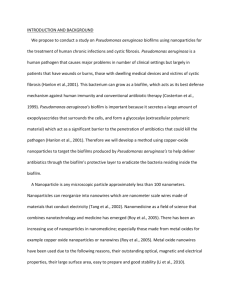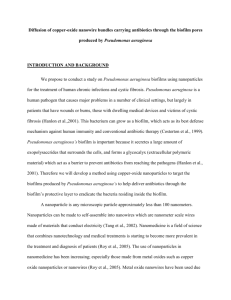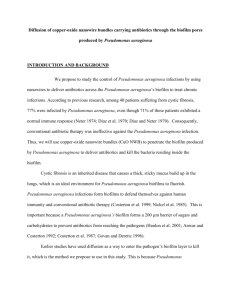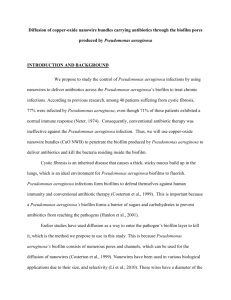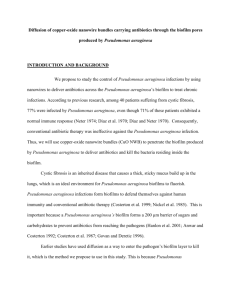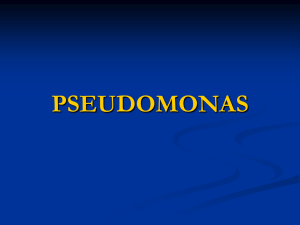Nanobots_proposal revised
advertisement
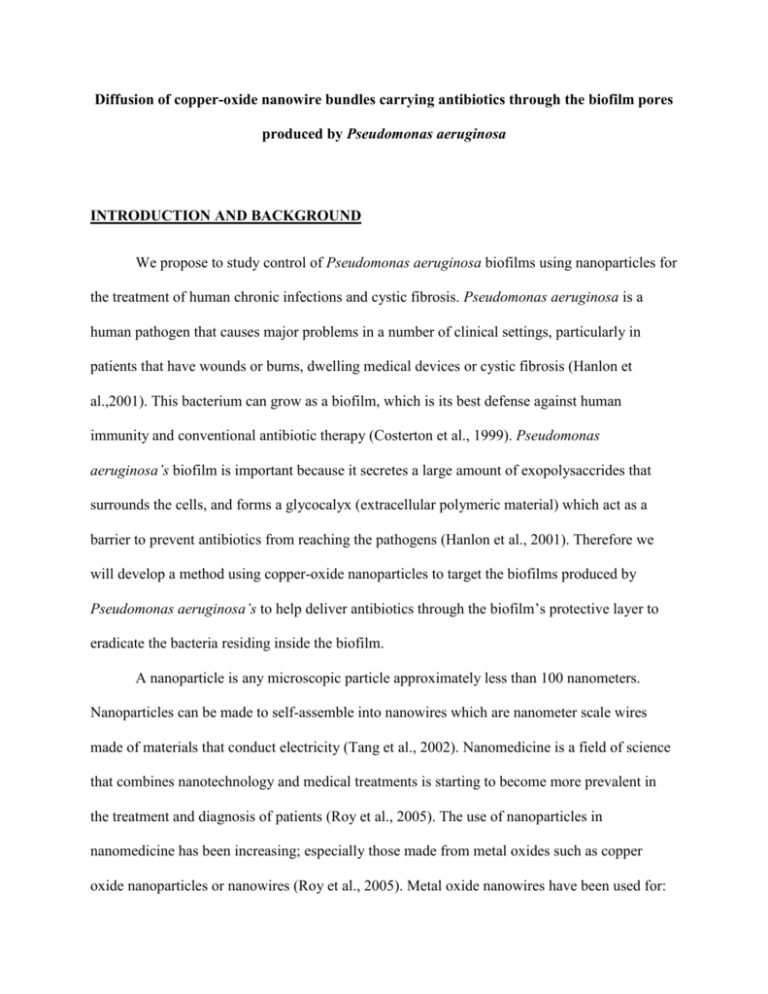
Diffusion of copper-oxide nanowire bundles carrying antibiotics through the biofilm pores produced by Pseudomonas aeruginosa INTRODUCTION AND BACKGROUND We propose to study control of Pseudomonas aeruginosa biofilms using nanoparticles for the treatment of human chronic infections and cystic fibrosis. Pseudomonas aeruginosa is a human pathogen that causes major problems in a number of clinical settings, particularly in patients that have wounds or burns, dwelling medical devices or cystic fibrosis (Hanlon et al.,2001). This bacterium can grow as a biofilm, which is its best defense against human immunity and conventional antibiotic therapy (Costerton et al., 1999). Pseudomonas aeruginosa’s biofilm is important because it secretes a large amount of exopolysaccrides that surrounds the cells, and forms a glycocalyx (extracellular polymeric material) which act as a barrier to prevent antibiotics from reaching the pathogens (Hanlon et al., 2001). Therefore we will develop a method using copper-oxide nanoparticles to target the biofilms produced by Pseudomonas aeruginosa’s to help deliver antibiotics through the biofilm’s protective layer to eradicate the bacteria residing inside the biofilm. A nanoparticle is any microscopic particle approximately less than 100 nanometers. Nanoparticles can be made to self-assemble into nanowires which are nanometer scale wires made of materials that conduct electricity (Tang et al., 2002). Nanomedicine is a field of science that combines nanotechnology and medical treatments is starting to become more prevalent in the treatment and diagnosis of patients (Roy et al., 2005). The use of nanoparticles in nanomedicine has been increasing; especially those made from metal oxides such as copper oxide nanoparticles or nanowires (Roy et al., 2005). Metal oxide nanowires have been used for: their outstanding optical, magnetic and electrical properties, their large surface area, their ease of preparation and their high stability (Li et al., 2010). Nanomedicine has used nanoparticles as platforms for diagnostic probes, and for effective targeted therapy (Roy et al., 2005). The involvement of nanoparticles in drug delivery, suggests that it’s possible to use copper oxide nanowires to carry antibodies through its biofilm to eliminate Pseudomonas aeruginosa. In attempts to kill the Pseudomonas aeruginosa pathogen, the biofilm seemed to be a major barrier to their success. Many studies have used diffusion as a way to enter the pathogen’s biofilm layer to kill it, which is the method we propose to use in this study. This is because Pseudomonas aeruginosa’s biofilm has an extracellular matrix that consists of numerous pores and channels, which can be used for the diffusion of oxygen and other ions (Costerton et al., 1999). Although we propose to use diffusion to go through the Pseudomonas aeruginos’s biofilm, there is a contradiction in the way agents or treatments are transported through this biofilm layer. Previous studies have targeted Pseudomonas aeruginos’s biofilm with metal ions, bacteriophages, and direct use of antibiotics whereas this proposed study will use copper oxide nanowires to carry antibiotics through the biofilm. Metal ions have been used to kill the pathogen by diffusing metal cations such as copper, lead, nickel and others individually through the Pseudomonas aeruginos’s biofilm (Harrison et al., 2005). High exposure of specific metals such as copper to the biofilm helped kill biofilm bacterial populations, although the method was ineffective when exposed with other metal cations (Harrison et al., 2005). This is because metal cations were observed to ionically interact with the negatively charged phosphodiester and other groups outside the biofilm, retarding their diffusion through the biofilm(Harrison et al., 2005). The use of bacteriophages as a method of treatment was successful in treating many infections, even those proved to be resistant to antibiotics initially such as Pseudomonas aeruginosa biofilm associated infections (Hanlon et al., 2001). This treatment diffused phages or viruses into the biofilm to directly kill the pathogen inside this biofilm. However phages were problematic due to the presence of an extracellular polymeric material that acted as a barrier to the virus’s entry through the biofilm (Hanlon et al., 2001). Finally in another study, there was direct use of antibiotics most susceptible to Pseudomonas aeruginosa pathogen such as Ciproflaxin and Tombramycin antibiotics for the treatment of the bacterium (Walters et al., 2003). Ciproflaxin diffused more readily through the biofilm than Tombramyacin. The slower penetration of Tombramycin was due to antibiotic binding to the extracellular matrix of Pseudomonas aeruginosa’s biofilm creating a diffusion barrier (Walters et al., 2003). These three past studies are significant to ours because they all faced a diffusion barrier presented by Pseudomonas aeruginosa’s biofilm. But none of the treatments used nanowires, which brings in the importance of the use of nanowires in our proposed study hoping to be more successful than the above treatments. The challenges found in past studies and the new discoveries in nanomedicine has led us to a new scientific question that: Can copper oxide nanowires carrying antibiotics diffuse through the porous structure of Pseudomonas aeruginosa’s biofilm? This question hypothesizes that copper oxide nanowires will help carry antibiotics susceptible to Pseudomonas aeruginosa’s pathogen through the biofilm to kill the pathogen from the inside. Therefore, the use of copper oxide nanowires in this study is proposed to reduce or remove the diffusion barrier through the biofilm found in previous studies. If these copper oxide nanowires diffuse through the biofilm successfully, then this study predicts the antibodies attached to the nanowires will be released to kill the pathogen inside the biofilm. One alternate hypothesis to this proposed research question could be: can copper oxide nanowires alone without antibiotics kill Pseudomonas aeruginosa pathogen when it successfully diffuses through the biofilm? This hypothesis predicts that there is no need to attach antibiotics to the nanowires if nanowires themselves are able to get rid of the infection. An alternate hypothesis could be: do copper oxide nanowires attached to antibiotics diffuse right through the Pseudomonas aeruginosa’s biofilm without killing the pathogen inside? This assumption could be possible because of the nature of the biofilm’s extracellular layer containing numerous in and out end pores, and also because infected bacterial cells mostly reside between these pores (Hanlon et al., 2001). Therefore, this hypothesis predicts these copper oxide nanowires carrying antibiotics might diffuse right through the biofilm pores before releasing the antibiotics to kill the pathogen. The above alternate hypotheses will be answered when the proposed research question is applied and successfully carried out as below. And if successful, we will have found a solution or treatment to many biofilm associated infections in all species such as cystic fibrosis. PROPOSED RESEARCH Pseudomonas aeruginosa Biofilm Synthesis We will follow Harrison’s (2006) procedure shown in Figure 1 to grow Pseudomonas aeruginosa biofilms using the Calgary Biofilm Device (CBD) and examine the biofilm’s structure using a confocal laser scanning microscope (CLSM). Figure 1. The experimental design to synthesize Pseudomonas aeruginosa biofilms, using LuriaBurtani Broth (LB) and the Calgary Biofilm Device (CBD) system; and examination of the biofilm’s structure using confocal laser scanning microscopy (CLSM) equipment (Harrison, 2006). We will grow our Pseudomonas aeruginosa biofilms at the optimal temperature of 35℃ (Harrison et al., 2006). We will prepare a pure culture of Pseudomonas aeruginosa by streaking two LB agar plates incubated for 24 hours each: one from the stock culture and the other from a single colony on the previous plate (Fig. 1A). To grow the biofilms, a 30-fold diluted McFarland inoculum will be prepared using the Pseudomonas aeruginosa pure culture (Fig. 1B), and a CBD peg lid will be inserted into a 96-well corrugated trough containing 22 mL of inoculum in each well. Then, the corrugated trough will be placed in a humidified incubator on a rocking table (set at 3.5 rocks per min.) and incubated for 24 hours (Fig. 1C). To examine Pseudomonas aeruginosa biofilm growth, we will place a CBD peg lid into a 96-well microtiter plate containing 200 µL of 0.9% NaCl in each well for 2 min. (Fig. 1D). Next, CBD pegs are removed with flamed pliers (Fig. 1E) and placed into acridine orange stained wells of a 96-well microtiter plate. Then, each peg will be mounted on a glass coverslip with 2 drops of 0.9% NaCl (Fig. 1I) and examined under a confocal laser scanning microscope (Fig. 1J). Synthesis of copper oxide nanowires We will follow the methods outlined by Li (2010) to synthesize the copper oxide nanowire bundles. We will create a one dimensional nanowire and combine it with an aqueous solution of CuCl2. This composite solution will be vacuum filteredand dried in an oven to produce our nanowires composition. The initial template will be removed with a solution of NaOH and the copper oxide nanowire bundles will dry a final time. Creating our copper nanowire carriers takes 24 hours to complete. We will get a visual representation of our carriers by using transmission electron microscopy (TEM) to generate an image. X-ray diffraction (XRD) analysis will be used to determine the structure and correct chemical composition of our carriers. Antibiotic Coupled Nanowire Synthesis We will use electrostatic interactions to carry our two types of antibiotics, Ciproflaxin and Tombramycin, with our copper oxide nanowire carrier. We will synthesize the nanowire carriers following the methods outlined in Li (2010), but we will reduce the copper oxide to form a charged Cu2+ nanowire carrier. Our antibiotics will carry an opposite charge by salvation and interact with the charged carriers by the method of electrostatics. We will use Fourier transformIR (FT-IR) to get spectra information on our copper-oxide nanowires, antibiotic, and the combination of nanowires and antibiotics. Controls and Test Samples Pseudomonas aeruginosa biofilms will be exposed to each parameter listed in Table 1 below: Table 1. Experimental group parameters tested with Pseudomonas aeruginosa biofilms. A EXPERIMENTAL GROUP Control B Antibiotic only C Nanowire only D Nanowire + Antibiotic EXPERIMENTAL TREATMENT PARAMETERS No antibiotic No magnesium-oxide nanowire Antibiotic No magnesium-oxide nanowire No antibiotic Magnesium-oxide nanowire Antibiotic fused Magnesium-oxide nanowire EXPECTED RESULT Growth Growth No growth (magnesium toxicity) No growth (antibiotic penetration) To prepare each of our test group parameters in Table 1 above, we will follow the procedures outlined in Table 2 below: Table 2. Experimental treatment group preparations. TEST GROUP PREPARATION PROCEDURE Control Add 200 µL of 0.9% NaCl to 24 wells of a 96-well microtiter plate of a randomly selected region (1, 2, 3, or 4) (Fig. 2) Antibiotic only Add 200 µL of antibiotic to 24 wells of a 96-well microtiter plate of a randomly selected region (1, 2, 3, or 4) (Fig. 2) Nanowire only Add copper-oxide nanowires to 24 wells of a 96-well microtiter plate containing 200 µL of 0.9% NaCl of a randomly selected region (1, 2, 3, or 4) (Fig. 2) Nanowire + Antibiotic Prepare 6 dilutions of antibiotic fused copper-oxide nanowires by factors of 10 using 200 µL of 0.9% NaCl. Add 200 µL of diluted antibiotic fused copper-oxide nanowires to 4 wells of a 96-well microtiter plate of randomly selected regions (1, 2, 3, or 4) and (I, II, III, IV, V, VI) (Fig. 2) Figure 2. A microtiter plate illustrating the regions of the treatment parameters control (A), antibiotic only (B), nanowire only (C), and antibiotic fused nanowire (D) (1, 2, 3, and 4), and the antibiotic fused nanowire dilution 10-1, 10-2, 10-3, 10-4, 10-5, and 10-6 aliquots (I, II, III, IV, V, and VI) (Ceri, 1999). Sample Size We expect little to no growth once we penetrate the biofilm layer of Pseudomonas aeruginosa with our nanowires carriers. To determine the sample size (N) we will a chi-squared logistical model to determine the noncentrality parameter (λ) using the formula N = λ / w2. The effect size (w) is the effect we are interesting in detecting. With our growth and no growth model we expect to see a high effect size of 0.5. With 9 degrees of freedom in our experimental design, we obtained a noncentrality parameter of 23.5894357. The sample size that is required for our experiment is 95. We will need at least 4 MBEC plates to get the required sample size. Analysis and Interpretation We will use Harrison’s (2006) viable cell counting procedure to determine Pseudomonas aeruginosa growth following each treatment parameter discussed previously. To collect our results after conducting each treatment parameter, we will follow the procedure outlined in Figure 3 below. First, we will rinse the biofilms by placing the CBD peg lid into a 96-well microtiter plate containing 200 µL of 0.9% NaCl in each well for 2 min (Fig. 1D). Then, the CBD pegs will be removed using flamed pliers and placed in a microtiter plate containing 200 µL of 0.9% NaCl in each well (Fig. 1E). This will be followed by sonication: using an Aquasonic 250HT ultrasonic cleaner (60 Hz for 5 min.) to remove the bacterial cells from the peg surface. The bacterial cells will be serially diluted in 0.9% NaCl, plated on LB agar medium, and incubated at 35℃ for 24 hours. The following day, we will count the number of colony forming units (CFUs) on each plate and record the results. Figure 3. Diagram of experimental procedure used for group tests B, C, and D (Table 1). Step D above will incubate with antibiotics for group tests B and D and with copper oxide nanowires for group tests C and D (Herrmann, 2010). Experimental Design We propose to follow the experimental procedure outlined below: Day 0 •Grow biofilms and make copper oxide nanowires Day 1 •1: Test for copper on nanowire and combine copper nanowire with biofilm •2: Couple antibiotics to copper oxide nanowires, tests coupling, dilutes antibiotics, and combines coupled nanowires with biofilm •3: Test for biofilm growth and do antibiotic test Day 3 Day 2 •1: Records results of toxicity test •2: Records results of test route •3: Grow Biofilms and make copper oxide nanowires •1: sonicates for toxicity test •2: sonicates for test route •3: Record results of antibiotic test REFERENCES Ceri H, Olson ME, Stremick C, Read RR, Morck D, Buret A. 1999. The Calgary biofilm device: New technology for rapid determination of antibiotic susceptibilities of bacterial biofilms. Journal of Clinical Microbiology. 37:1771-1776. Costerton JW, Stewart PS, Greenberg EP. 1999. Bacterial biofilms: A common cause of persistent infections. Science. 284: 1318-22. Hanlon WG, Denyer Ps, Olliff JC, Ibrahim JL. 2001. Reduction in exopolysaccharide viscosity as an aid to bacteriophage penetration through Pseudomonas aeruginosa biofilms. American Society for Microbiology. 67: 2746-53. Harrison JJ, Turner RJ, Ceri H. 2005. Persister cells, the biofilm matrix and tolerance to metal cations in biofilm and planktonic Pseudomonas aeruginosa. Biofilm Research Group. University of Calgary. 7: 981-94. Harrison JJ, Ceri H, Yerly J, Stremick CA, Hu Y, Martinuzzi R, Turner RJ. 2006. The use of microscopy and three-dimensional visualization to evaluate the structure of microbial biofilms cultivated in the Calgary biofilm device. Biological Procedures Online. 8:194215. Herrmann G, Yang L, Wu H, Song Z, Wang H, Hoiby N, Ulrich M, Molin S, Riethmuller J, Doring G. 2010. Colistin-tobramycin combinations are superior to monotherapy concerning the killing of biofilm Pseudomonas aeruginosa. The Journal of Infectious Diseases. 202:1585-1592. Li Y, Zhang Q, Li J. 2010. Direct electrochemistry of hemoglobin immobilized in CuO nanowire bundles. Talanta. 83: 162-66. Tang Z, Kotov AN, Giersig M. 2002. Spontaneous organization of single ctde nanoparticles into luminescent nanowires. Science, new series. 297: 237-40. Roy I, Ohulchanskyy YT, Bharali JD, Pudavar EH, Mistretta AR, Kaur N, Prasad NP, Rentzepis MP. 2005. Optical tracking of organically modified silica nanoparticles as DNA carriers. A nonviral, nanomedicine approach for gene delivery. National Academy of Science of the United States of America. 102: 279-84. Walters CM, Roe F, Bugnicourt A, Franklin MJ, Stewart SP. 2003. Contributions of antibiotic penetration, oxygen limitation, and low metabolic activity to tolerance of Pseudomonas aeruginosa biofilms to ciprofloxacin and tobramyacin. American Society for Microbiology. 47: 317-23.

